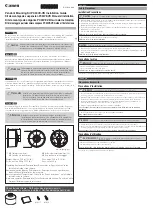
4
500KG VERTICAL TRANS STAND
OPERATION
TESTING OPERATION
1.
Briefly test the Transmission Jack operation as follows BEFORE using to lift any load.
2.
Turning the Release Valve (3) counter clock wise allows jack to be lowered. Once the Releasve Valve (3) is released, it will
automatically return to raising position.
3.
To raise the Transmission Jack, pump the Foot Pedal (7) a few times to raise jack about halfway. If the Hydraulic Ram (2)
does not begin to rise after a few pumps, check to make sure the Release Valve (3) is firmly closed.
4.
With the Transmission Jack raised, turn the Release Valve (3) slowly counter clockwise to lower the Transmission Jack. A
normal hissing sound may be heard as the Transmission Jack lowers and pressure in Hydraulic Cylinder (6) is released.
PREPARING WORK AREA
Caution:
Before using the Transmission Jack, it is important to prepare work area properly. Follow this procedure
each time the Transmission Jack is used to help prevent property damage and or serious injury.
1.
Thoroughly inspect the Transmission Jack for damage or wear before each use. Briefly test operation of unloaded jack
before using to lift any load. If the Transmission Jack is damaged or is malfunctioning DO NOT LIFT ANY LOAD until the
problem is corrected.
2.
Consult vehicle owner’s manual for safety precautions, Transmission weight, and location of support areas on transmission.
The Working Load Limit of the Transmission Jack is 500 kg. NEVER EXCEED WORKING LOAD LIMIT OF TRANSMISSION JACK
3.
Clear children and others from work area before commencing work. Another adult should be nearby for extra safety and
assistance but must be clear of vehicle as it is worked on.
4.
Clear obstructions from work area. Working in tight or cluttered work areas is dangerous.
5.
Be sure the Transmission Jack and vehicle are on solid, level ground such as paved or concrete driveway or garage floor
so the Transmission Jack is free to roll. Uneven or sloped surfaces create hazardous working conditions and dangerously
impeded the function of the Transmission Jack.
6.
With vehicle in proper position, set vehicle’s parking brake or emergency brake and put gearshift in park (manual
transmissions should be placed in lowest gear). TURN VEHICLE IGNITION OFF AND TO THE “LOCK” POSITION making sure
steering wheel locks.
7.
Chock all wheels of vehicle to prevent vehicle rolling. Using wedge-shaped blocks that tyre cannot roll over, position one
chock tight against the tyre in both forward and reverse rolling paths.
8.
Plan location of Transmission Jack beneath vehicle, making sure Transmission Jack will be contacting only the transmission
area of vehicle. Consult vehicle owner’s manual for recommended areas.
OPERATION
Lifting a transmission, gearbox, or differential using the Transmission Jack can be dangerous. This Transmission Jack is designed
and intended for use by properly trained and experienced personnel only. If you are not familiar with the proper and
safe operation of a Transmission Jack, do not use until proper training and knowledge have been obtained.
1.
With lifting arm completely lowered, roll the Transmission Jack into position beneath the Transmission of the vehicle.
2.
Slowly pump the Foot Pedal (7) until Saddle (1) just begins to contact support area on underside of transmission.
3.
Inspect position of Transmission Jacks Saddle (1) making sure it is centered and properly supporting the transmission.
4.
Pump Foot Pedal (7) again until Saddle (1) is firm against the transmission.
5.
Ensure transmission is securely attached to the Saddle (1), the load may slip or fall if not securely restrained.
6.
Unbolt the transmission from vehicle
7.
Slowly turn Release Valve (3) counter clockwise to slowly and smoothly lower transmission. Excessive speed or jerky motion
can cause the transmission to slip leading to property damage or personal injury.
Working on Vehicle
Any transmission being supported by a jack creates a potentially hazardous working environment.
Never place any part of your body beneath a transmission supported by a jack. Be careful of forces applied to transmission
such as torque on a nut or bolt these forces could cause transmission to become unstable on transmission saddle
MAINTENANCE AND STORAGE
Lubricating
Moving parts on the Transmission Jack should be lubricated occasionally with a light machine oil to maintain efficient operation.
Apply oil to joints on lift arm hinges, push rods, handle base, castors, front wheels, and adjusting screws, wipe away excess oil
with a soft cloth.
Summary of Contents for K12120
Page 6: ...6 www kincrome com au...
























